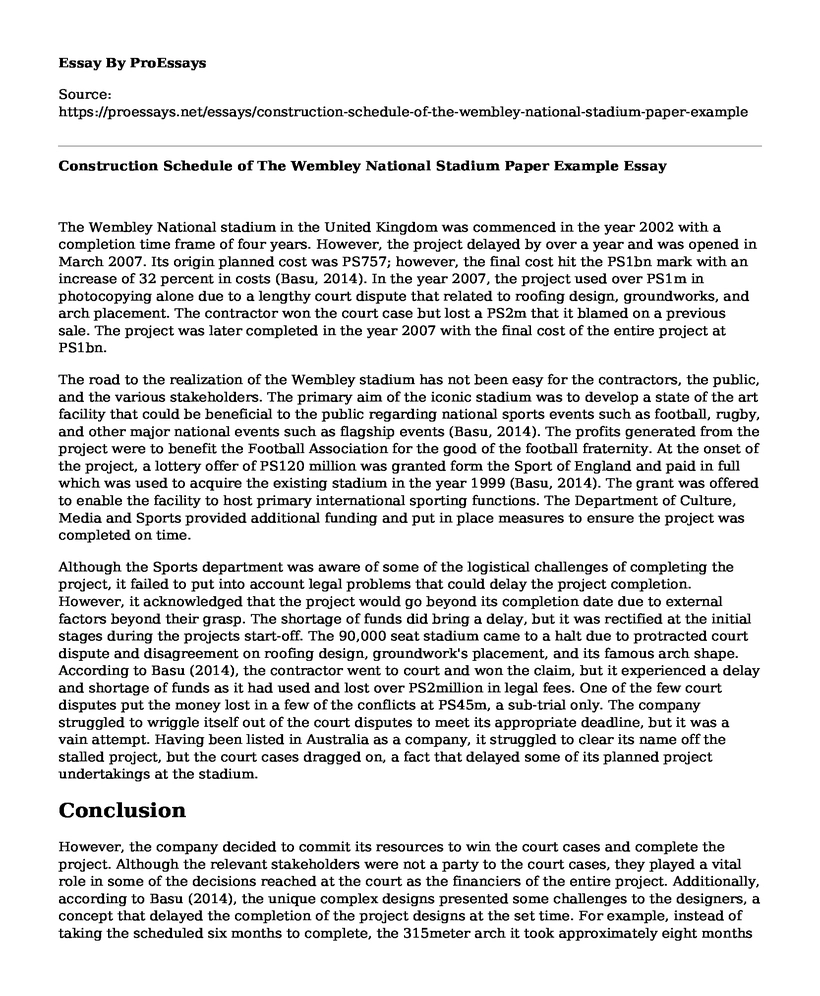The Wembley National stadium in the United Kingdom was commenced in the year 2002 with a completion time frame of four years. However, the project delayed by over a year and was opened in March 2007. Its origin planned cost was PS757; however, the final cost hit the PS1bn mark with an increase of 32 percent in costs (Basu, 2014). In the year 2007, the project used over PS1m in photocopying alone due to a lengthy court dispute that related to roofing design, groundworks, and arch placement. The contractor won the court case but lost a PS2m that it blamed on a previous sale. The project was later completed in the year 2007 with the final cost of the entire project at PS1bn.
The road to the realization of the Wembley stadium has not been easy for the contractors, the public, and the various stakeholders. The primary aim of the iconic stadium was to develop a state of the art facility that could be beneficial to the public regarding national sports events such as football, rugby, and other major national events such as flagship events (Basu, 2014). The profits generated from the project were to benefit the Football Association for the good of the football fraternity. At the onset of the project, a lottery offer of PS120 million was granted form the Sport of England and paid in full which was used to acquire the existing stadium in the year 1999 (Basu, 2014). The grant was offered to enable the facility to host primary international sporting functions. The Department of Culture, Media and Sports provided additional funding and put in place measures to ensure the project was completed on time.
Although the Sports department was aware of some of the logistical challenges of completing the project, it failed to put into account legal problems that could delay the project completion. However, it acknowledged that the project would go beyond its completion date due to external factors beyond their grasp. The shortage of funds did bring a delay, but it was rectified at the initial stages during the projects start-off. The 90,000 seat stadium came to a halt due to protracted court dispute and disagreement on roofing design, groundwork's placement, and its famous arch shape. According to Basu (2014), the contractor went to court and won the claim, but it experienced a delay and shortage of funds as it had used and lost over PS2million in legal fees. One of the few court disputes put the money lost in a few of the conflicts at PS45m, a sub-trial only. The company struggled to wriggle itself out of the court disputes to meet its appropriate deadline, but it was a vain attempt. Having been listed in Australia as a company, it struggled to clear its name off the stalled project, but the court cases dragged on, a fact that delayed some of its planned project undertakings at the stadium.
Conclusion
However, the company decided to commit its resources to win the court cases and complete the project. Although the relevant stakeholders were not a party to the court cases, they played a vital role in some of the decisions reached at the court as the financiers of the entire project. Additionally, according to Basu (2014), the unique complex designs presented some challenges to the designers, a concept that delayed the completion of the project designs at the set time. For example, instead of taking the scheduled six months to complete, the 315meter arch it took approximately eight months to reach its completion (Basu 2014). The contractors after that put in place and increased its human resources and capital to recover the time lost in the design phase and court disputes, a feat that saw Multiplex complete the project a year later with a completion cost of PS1bn, an increase of 32 percent in cost. However, avoiding the court dispute by Multiplex could have prevented the delay and reduced the completion time. At the same time, prior planning by the contractor on the design of the arch and vital components of the project could have seen the project completed within the stipulated time frame.
References
Basu, R. (2014). Managing quality in projects: An empirical study. International journal of project management, 32(1), 178-187.
Cite this page
Construction Schedule of The Wembley National Stadium Paper Example. (2022, Jun 27). Retrieved from https://proessays.net/essays/construction-schedule-of-the-wembley-national-stadium-paper-example
If you are the original author of this essay and no longer wish to have it published on the ProEssays website, please click below to request its removal:
- Development of Groups in Stages Essay Example
- Leadership and Decision Making Questions and Answers Paper Example
- Effective Political Leadership Paper Example
- Managing Security Risks Paper Example
- Managerial Decision-Making Essay Example
- Essay Example on Developing a Diversity Training Plan: Strategies and Implementation
- Paper Sample on Effective Management Policies: Cert Revocation Lists, Cert Auth & Digital Certs







